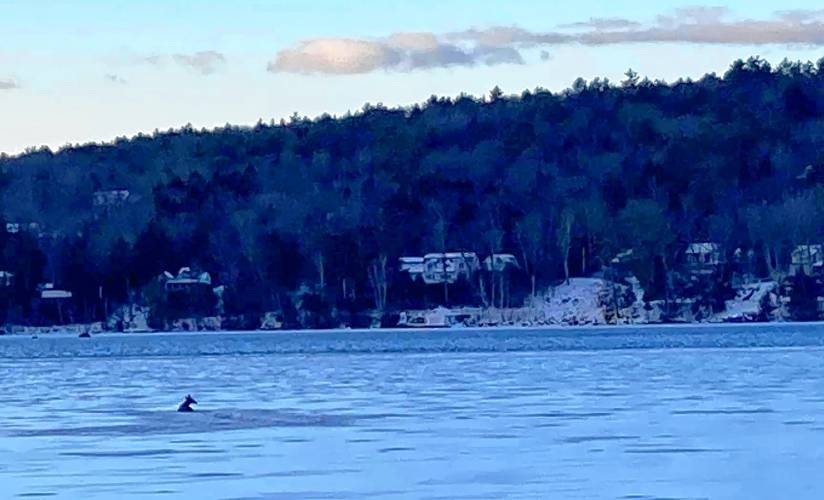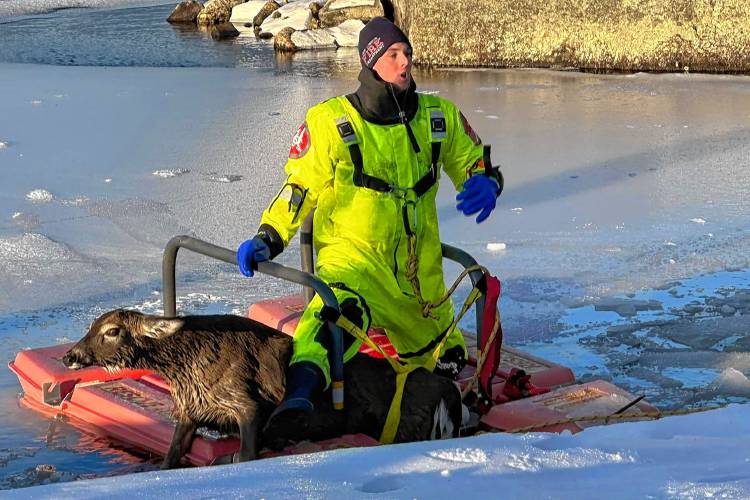Oh, deer!: Upper Valley doe rescue illustrates hazards of thin ice
| Published: 01-17-2024 1:42 PM |
NEW LONDON — The New London Fire Department was on thin ice Sunday morning when it rescued a partially submerged deer from Pleasant Lake.
Just before 7:30 a.m., with temperatures around freezing, the Fire Department received an emergency call from a Lakeshore Drive resident. A doe, about 300 feet from shore, was unable to pull herself back onto the fragile ice, of less than an inch thick, that she’d fallen through.
Firefighters Max Isley and Andrew Sarnevitz gingerly made their way out to the doe, tethered to shore by a rope. They hauled the deer out onto an “ice sled,” which evenly distributed her weight, and pulled her back to land.
“The deer was sort of flailing around, but as soon as (Andrew) put his arms around her, she stopped struggling,” Fire Chief Jason Lyon said.
While the distressed animal was certainly in need of assistance, the rescue was less of “an emergency operation,” Lyon said, than a “phenomenal training” opportunity.
It was colder over the weekend than it had been in the ones preceding it, but that did little to stabilize much of Pleasant Lake.
Ice builds up gradually, so it matters where the mercury has been landing in the recent past. This winter, “we’ve had some conditions that have been below freezing, and then other days that it’s been almost 60 degrees,” Lyon said.
Plus, the vast expanse of the 600-acre lake — larger by 200 acres than Little Lake Sunapee — remains consistently windy, which cuts away at ice thickness.
Article continues after...
Yesterday's Most Read Articles
 Youth rally against New Hampshire’s bill allowing medical aid in dying
Youth rally against New Hampshire’s bill allowing medical aid in dying
 As site testing begins on new middle school site, activists file to put location debate on the ballot
As site testing begins on new middle school site, activists file to put location debate on the ballot
 Lawyers and lawmakers assert the Department of Education is on the verge of violating the law
Lawyers and lawmakers assert the Department of Education is on the verge of violating the law
 A May tradition, the Kiwanis Fair comes to Concord this weekend
A May tradition, the Kiwanis Fair comes to Concord this weekend
 Neighboring landowner objection stalls Steeplegate redevelopment approval
Neighboring landowner objection stalls Steeplegate redevelopment approval
 State senator passes out on senate floor
State senator passes out on senate floor
Pleasant Lake only froze all the way across last year in the second week of March, the latest in recent memory, he said.
The New Hampshire Fish and Game Department recommends a minimum of six inches of ice before venturing out onto a water body on foot and between eight and 10 inches for snow machine or all-terrain vehicle travel.
“With erratic weather conditions, some areas of ice may look safe but may not be,” said Col. Kevin Jordan, chief of the department’s law enforcement division, in a news release last week. “We are urging people to check the ice thickness before going out onto any frozen water body.”
Lyon said he’s noticed people heading out on lakes even while there are still patches of open water. “It’s crazy,” he said, emphasizing that it endangers “the rescuers that potentially need to go out and save them.”
The department responds to one or two ice rescue calls a year, but as temperatures remain inconsistent, Lyon stays on guard.
He cautioned against staging a rescue without first calling in professional assistance. It’s better to err on the side of ringing up the fire department, “otherwise we have to go get two people who have fallen through ice,” he said.
As for the doe, “a coyote might have chased her out there, or she thought it was just a regular field or whatnot,” Lyon said.
Once the deer was returned to more solid ground, the firefighters on the scene positioned themselves so she wouldn’t run back onto the ice, perhaps addled by the drama of her morning.
The responders successfully herded the doe back into the woods, Lyon said. But first “she gave herself a long shake to dry off,” he said.
Frances Mize is a Report for America corps member. She can be reached at fmize@vnews.com or 603-727-3242.









 Barrington entrepreneur giving new life to single-use plastic
Barrington entrepreneur giving new life to single-use plastic For the first time, education commissioner speaks publicly about minimum standards revision, but he faces skepticism
For the first time, education commissioner speaks publicly about minimum standards revision, but he faces skepticism Adam Montgomery sentenced to minimum 56 years on murder charges in young daughter’s death
Adam Montgomery sentenced to minimum 56 years on murder charges in young daughter’s death
